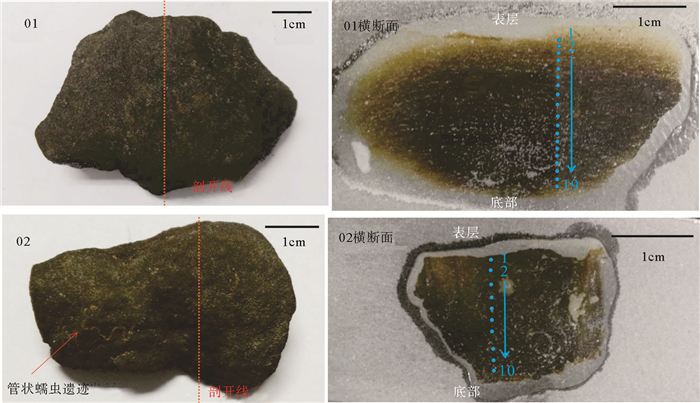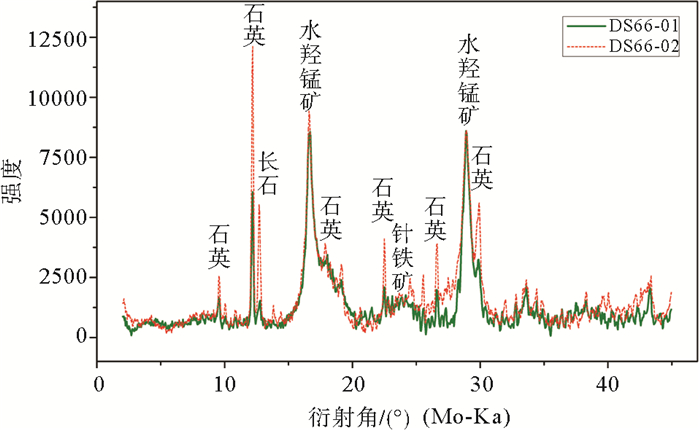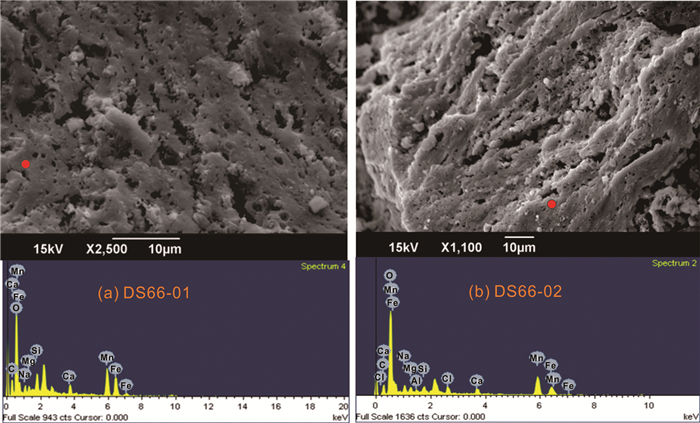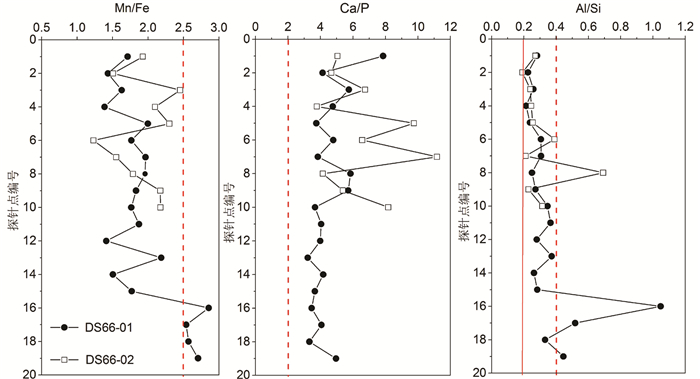Mineralogy and geochemisry of ferromanganese crusts from Guanshi Seamount in the eastern South China Sea
-
摘要:
对于开阔大洋海山结壳的矿物组成和地球化学特征研究已经比较深入,但对边缘海海山铁锰结壳的研究却较少。以在南海东部管事海山上采集的两块铁锰结壳为研究材料,对其进行了X射线衍射、扫描电镜及电子探针微区的分析,结果显示结壳矿物以水羟锰矿为主,含有少量针铁矿,碎屑矿物主要是石英和长石。结壳的显微结构呈现条带状分布,有10~15μm长的空隙和0.5μm直径大小的孔洞。相对于大洋结壳,结壳的Mn含量较高,与马尼拉海沟附近火山喷发物质有关,但Cu、Co和Ni含量更低,可能与边缘海沉积速率高或有机络合物吸附有关。矿物组成及元素比值表明结壳主要是水成的,但未发生明显磷酸盐化作用。元素比值和相关性表明,Mn主要来源于南海扩张停止后火山喷发、玄武岩风化形成溶解Mn;Fe与Si元素均来自火山碎屑、生源物质和陆源物质,还受到管状蠕虫吸附的影响。南海管事海山结壳是在富氧环境中上升流作用下选择性吸附水体中溶解化学元素缓慢沉积而成。结壳中元素含量随时间变化趋势反映了南海的古环境变化。
Abstract:Although the mineral composition and geochemistry of ferromanganese crusts in the open ocean are well understood to researchers, those on seamounts in a marginal sea remains little known. In this study, two ferromanganese crust samples are collected from the Guanshi seamount located in the eastern South China Sea (SCS). We analyzed the mineral composition, microstructures, and major elements contents of the ferromanganese crusts, by means of X-ray diffraction (XRD), scanning electron microscope (SEM) and electron microprobe, respectively. Both of the two ferromanganese crusts are dominated by vernadite with a small amount of geothite, while the detrital minerals dominated by quartz and feldspar. The two crusts are all striped in microstructure, with pores of 10-15 μm and holes of 0.5 μm in diameters. Compared with those from the open ocean, the crusts from Guanshi seamount is higher in Mn, due to the volcanic eruption near the Manila Trench, and lower in Cu, Co and Ni contents due to the higher deposition rate and higher adsorption of organic complex in the South China Sea. Mineral composition and element ratios indicate that the two crusts are both hydrogenetic, without obvious phosphatization. The element ratios and correlation of elements show that Mn mainly deposited from the dissolved Mn supplied by volcanic eruption and the weathering of basalt formed in the post-spreading stage of the South China Sea. Fe and Si elements are both derived from volcanic, biogenic and terrestrial materials, and also affected by the adsorption of tubular worms. Two crusts from the Guanshi seamount in the South China Sea are formed by the slow accumulation of dissolved chemical elements of seawater affected by upwelling under an oxygen enriched environment. The temporal variations of element contents in the ferromanganese crusts reflect paleoenvironmental evolution history of the South China Sea.
-
铁锰结壳是一种常生长于海底地势较高处(主要是海山)硬质基岩(或沉积物)上的“壳状”沉积矿产,富含铁、锰和稀土(Rare Earth Elements,简写REEs)等元素[1, 2]。铁锰结壳主要分布于碳酸盐补偿深度(Carbonate Compensation Depth,简写CCD)以上、最低含氧层(Oxygen Minimum Zone,简写OMZ)中或以下水深500~3500m的平顶海山、海台顶部和斜坡的裸露基岩上[3-5]。
此前对铁锰结壳的研究主要集中在开阔大洋海山结壳上,并在结壳的矿物组成、结构构造、化学组成、物质来源及古海洋环境应用等方面取得了丰硕成果[6-15],近几年来开始重视对边缘海地质背景下形成的海山铁锰结壳研究[16, 17]。南海海山位于大陆和菲律宾岛弧之间,是南海扩张期停止后形成的[18]。关于南海海山结壳(结核)的研究主要集中在尖峰海山、蛟龙海山结核的矿物组成和元素特征上[19, 20]。与以前的南海海山结壳研究相比,本文选取了更靠近南海马尼拉海沟和中央断裂带的管事海山上两块铁锰结壳样品,对其进行X射线衍射分析(XRD)、扫描电镜分析(SEM)、电子探针微区分析(EMPA),获得管事海山铁锰结壳的矿物学和地球化学基本特征,同时利用相关性分析了南海管事海山结壳的物质来源及形成环境,为该区海山铁锰结壳的古海洋古环境研究提供了基础资料,还能为海底资源评价及开采提供科学依据。
1. 研究区概况
南海扩张已停止16Ma,海山是南海扩张停止后几百万年出现的[21],南海大部分海山位于中央海盆,其中管事平顶海山是南海众多的海山之一,其右侧靠近马尼拉海沟(图 1)。管事海山山顶坡度小于1°,山顶面积约145km2。海山基座水深约4250m,山顶水深460m,高差3540m(图 1)。海山走向为东北,长65km,宽约34km,面积约2119km2,坡度约为20° [22]。
2. 方法
2.1 样品采集
2015年9月使用箱式采样器在南海东部管事平顶海山(采样点坐标为17°9′24″N、118°48′47″E,水深1478m)采集的2个铁锰结壳为研究材料,分别命名为DS66-01(简写为01)和DS66-02(简写为02),其中01呈褐黑色,长近6cm,厚度约2cm(图 2),而02亦呈褐黑色,长近4cm,厚度约1.3cm,表面还有管状蠕虫的遗迹(图 2)。
2.2 样品处理和分析
将铁锰结壳01和02分别沿着生长方向切割出生长剖面,选取部分铁锰结壳用玛瑙碾钵磨细至200目,将磨好的样品进行XRD衍射分析。XRD衍射分析仪器为理学DMAX RapidⅡ型点光源面探测器X射线衍射仪,靶材-Mo (Mo Kα =0.71073),功率50kV-90mA,准直管(入射线束斑直径)0.1mm,样品管直径0.5mm,曝光时间9分钟。本实验在南京大学内生金属矿床国家重点实验室的XRD实验室完成。
将结壳01和02样品选取部分破碎成小块,选取01和02样品中小颗粒(长约1~2mm)进行扫描电镜分析,使用JSM-6490型扫描电镜观察矿物的表面形貌,加速电压20kV;成分分析由OxfordINCAX射线能谱仪测定,WD为10mm。SEM分析在南京大学内生金属矿床成矿机制研究国家重点实验室完成。
将铁锰结壳01和02沿着生长方向切割出生长剖面,制成电子探针光片,整个过程中要进行固结,得到合适的样品,然后进行抛光、清洗、烘干(< 50℃),最后喷碳干燥后进行电子探针分析(图 2)。用电子探针仪器分析结壳01和02剖面表层到底部探针点的Mn, Fe, Si, A1, P, Ca, Co, Ni, Cu, K, Na和Mg等12种元素含量。所用仪器为JEOL JXA-8100电子探针分析仪。测试条件如下:仪器加速电压为15kV,束流为20nA,束斑直径为3μm。从表层向底部每隔100μm左右打一个点,从光片样品外部向里面沿着生长轨迹打点(图 2)。电子探针分析在南京大学内生金属矿床成矿机制研究国家重点实验室完成。
3. 结果
3.1 结壳矿物组成
南海海山铁锰结壳01和02矿物组成均以水羟锰矿(δ-MnO2)为主,还含少量石英、长石和针铁矿(图 3)。两个结壳中水羟锰矿的峰型均呈弥散峰,且峰型大部分重合,显示两个结壳的锰相矿物结晶程度不高,其水羟锰矿含量差距较小(其中01结壳约87.2%,02结壳约90.1%)。由于结壳中铁相矿物结晶程度低,运用X射线衍射方法很难完整反映出其铁相矿物组成特征,能够辨识的铁相晶质矿物主要是针铁矿(其中01结壳约2.2%,02结壳约3.3%)。结壳01碎屑矿物石英和长石含量分别为3.7%和6.9%,02石英和长石含量分别为4.6%和2%,可能原因是结壳吸附的碎屑矿物等元素差异引起。
3.2 扫描电镜图像
两块铁锰结壳扫描电镜图像及其能谱图如图 4所示,铁锰结壳显微结构呈现条带状分布,铁锰结壳中有10~15μm长的空隙和0.5μm直径大小的孔洞,可能为生物遗迹;能谱图显示两个结壳均以Mn, Fe和Si等元素为主。
3.3 电子探针微区分析结果
由于铁锰结壳疏松多孔且含水,因此电子探针分析的氧化物总量通常只有40%~70%。为了保证所分析测点的准确性,本文根据前人的探针分析结果和方法删去了少数Si>10%、Al>4%和元素总量 < 40%的测点结果[25],前一种测点的Fe和Mn含量低,而Al和Si含量较高,元素总量大于40%,可能代表了黏土或生物碎屑等;后一种测点不仅Fe和Mn含量都低,Si和Al含量也表现为低值,元素总量小于40%,极有可能是打在结壳微孔隙中造成的。
铁锰结壳01和02的Fe、Mn、Ca、P、Al、Si、Cu、Co、Ni等主要元素含量的分布趋势如图 5所示。结壳01中Mn,Fe,Cu,Co和Ni元素含量平均值分别为32.9%、17.5%、0.05%、0.08%和0.11%,Ca,P,Al,Si和Mg元素含量平均值分别为3.4%、0.8%、1.3%、4.1%、1.4%。结壳02中Mn,Fe,Cu,Co和Ni元素含量平均值分别为30.7%、16.1%、0.09%、0.09%和0.08%,Ca,P,Al,Si和Mg元素含量平均值分别为3.3%、0.6%、1.5%、4.8%、1.6%。
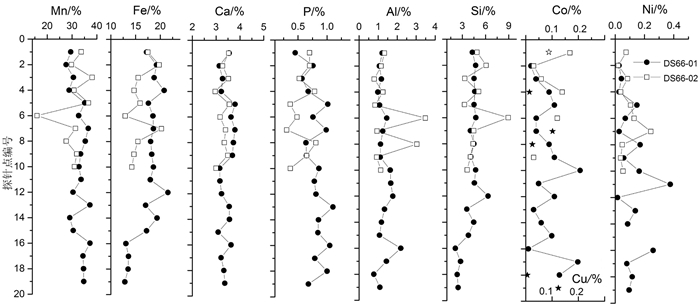 图 5. 结壳01和02的电子探针微区点的元素含量(结壳01元素含量除去Cu外以黑点表示,Cu以黑五角星标识,结壳02元素含量除去Cu外以白正方形表示,Cu以白五角星表示),部分元素Cu,Co和Ni含量在检测限以下Figure 5. EPMA(Electron microprobe analysis)results of Fe-Mn crusts (wt%) from Guanshi seamount in the SCS(01=Balck point: point 1-19 from the top to the bottom; 02=White square: point 1-10 from the top to the bottom). A portion of Cu, Co and Ni are below the detection limit. Cu are Balck star and White star in crusts 01 and 02, respectively
图 5. 结壳01和02的电子探针微区点的元素含量(结壳01元素含量除去Cu外以黑点表示,Cu以黑五角星标识,结壳02元素含量除去Cu外以白正方形表示,Cu以白五角星表示),部分元素Cu,Co和Ni含量在检测限以下Figure 5. EPMA(Electron microprobe analysis)results of Fe-Mn crusts (wt%) from Guanshi seamount in the SCS(01=Balck point: point 1-19 from the top to the bottom; 02=White square: point 1-10 from the top to the bottom). A portion of Cu, Co and Ni are below the detection limit. Cu are Balck star and White star in crusts 01 and 02, respectively4. 讨论
4.1 南海海山铁锰结壳的地球化学特征
南海东部管事海山和大洋、边缘海海山铁锰结壳的Mn、Fe、Co、Cu和Ni含量如表 1所示。管事海山铁锰结壳的Mn和Fe含量平均值分别为31.8%和16.8%(表 1)。研究区Mn含量都大于大洋和边缘海的结壳中Mn含量,而与中太平洋YJC海山新结壳Mn含量相近(表 1),这可能与管事海山附近的火山活动和断裂构造有关。管事海山位于马尼拉海沟和中央断裂带附近,马尼拉海沟是活动大陆边缘(图 1),地震和火山活动频繁,上地幔Mn元素喷出,导致管事海山附近最低含氧带下水体中溶解Mn元素含量高,最终结壳吸附的Mn含量值高。邱传珠也认为Mn物质来源主要来自上地幔物质,其沿断裂带大量富集[28]。Zhong等也发现南海中央海盆结核结壳中Mn高含量带与中央构造线方向相一致,显示Mn与断裂构造活动有关系[20]。研究区海山结壳中Fe含量与太平洋结壳相差不多,但比加利福尼亚边缘海、印度洋和大西洋结壳含量低7%、5.5%和4.1%(表 1)。造成结壳中Fe含量差别可能的一个原因是来自大陆物质受到太平洋西部岛弧-海沟的阻挡,陆源Fe较少输运到太平洋西部海山,而印度洋、大西洋和加利福尼亚边缘海周边没有岛弧-海沟阻挡,陆源Fe能直达海山结壳区。
表 1. 全球大洋和海域结壳的Mn, Fe, Cu, Co和Ni百分含量Table 1. Compiled chemical composition of crusts from selected areas of the global ocean% 元素含量 Mn Fe Co Ni Cu 来源 南海 管事海山 31.8 16.8 0.09 0.10 0.07 本文 西太平洋 麦哲伦海山 20.1 16.3 0.68 0.34 0.15 [26] 西太平洋 马尔库斯-威克海山 19 16.5 0.64 0.39 0.09 [26] 中太平洋 YJC海山新结壳 28.9 15.4 0.91 0.67 0.07 [27] 北太平洋 最好的结壳带 22.8 16.9 0.67 0.42 0.1 [2] 南太平洋 结壳区 21.7 18.1 0.62 0.46 0.11 [2] 加利福尼亚边缘海 海山区 19.5 23.8 0.31 0.23 0.04 [17] 大西洋 14.5 20.9 0.36 0.26 0.09 [2] 印度洋 17 22.3 0.33 0.26 0.11 [2] 结壳01和02中Mn,Fe和Si元素相差稍大,结壳01中Mn和Fe含量比结壳02分别高1.8%、1.4%,可能与结壳01表面积较大吸附更多铁锰元素有关。结壳02中Si含量比01要高0.7%,可能与表面管状蠕虫导致生物成因Si更高有关。两个结壳其余元素含量则相差不大,在0.2%范围内。
管事海山铁锰结壳的Co,Ni和Cu含量平均值分别为0.09%、0.1%和0.07%(表 1),与大洋结壳相比,研究区Co、Ni和Cu含量较低。太平洋结壳的Co含量是研究区结壳的7~10倍,Ni含量是研究区的4~7倍,而加利福尼亚边缘海、大西洋和印度洋的Co含量是研究区的3倍多,Ni含量是研究区的2.5倍左右。研究区Cu含量很多数据点低于检测限,测出Cu含量平均值大于加利福尼亚边缘海海山上结壳0.04%,低于开阔大洋结壳Cu含量。
有3个可能原因导致结壳中Co,Ni和Cu等微量元素含量降低。一是结壳生长速率太快引起。在铁锰结壳生长过程中,海水中Co元素进入铁锰结壳中的速率是均一的,因此铁锰结壳的生长速率越大,Co含量越低;反之含量越高[29]。但是利用Lyle等[30]经典公式R=16.0 [EMn/(EFe)2] + 0.448来计算南海海山结壳01和02的生长平均速率分别为2.17和2.34mm/Ma,都在水成型结壳(沉积速率为1~15mm/Ma)范围内[25],因此排除海山结壳生长太快的原因。二是与南海边缘海内沉积速率过快有关,利用管事海山旁沉积柱算出3.7万年以来南海东部沉积速率约为0.1mm/a[31],远高于太平洋沉积速率0.32mm/ka[32],沉积速率过快导致结壳可吸附海水中微量元素数量受到影响。三是南海生物量和有机质含量远高于开阔大洋,鲍根德和李全兴研究得出南海铁锰结壳中Mn来源丰富的地方,Ni相对于Cu更富集,这可能与水体中Cu2+比Ni2+ 更易被生物利用所致[33]。而且有机质含量高易于形成有机络合物,更多吸附水体中微量元素,导致结壳可吸附水体中微量元素含量减少[34]。南海海山铁锰结壳中Cu、Co和Ni的低含量是边缘海型结壳的重要特征。
4.2 南海海山铁锰结壳的成因及其物源研究
通常大洋铁锰矿床Mn/Fe比值小于2.5,被认为是水成成因的,Mn/Fe比值大于2.5,被认为是其受沉积物早期成岩作用影响强度的指示,Mn/Fe比值愈大,受成岩作用的影响愈强[6]。研究区海山两个铁锰结壳的探针点Mn/Fe如图 6所示,从南海海山结壳表层到底部,Mn/Fe一直为1.5~2.5,只是01底部4个点大于2.5,说明结壳大部分是水成成因的,可能01结壳底部受到成岩作用的影响。结壳的主要矿物是水羟锰矿,这代表高氧化条件下沉淀的水成氧化物,在富氧环境下,结壳的主要矿物水羟锰矿和非晶质针铁矿因具有较大的表面积,有较强的胶体吸附能力,使结壳缓慢生长。
一般来说碳氟磷灰石(CFA)Ca/P比值多小于2 [26]。研究区海山两个铁锰结壳的探针点Ca/P如图 6所示,结壳的Ca/P值远大于CFA的Ca/P值,都大于2,说明海山结壳没有发生明显磷酸盐化的影响。Koschinsky等指出磷酸盐化型结壳的P含量可能达到1.0%~1.5%[35],非磷酸盐化型结壳中P含量较低。本文两块结壳的P含量均小于1.0%(图 5),也说明海山结壳未发生磷酸盐化。
研究区海山铁锰结壳的探针点Al/Si如图 6所示,Al/Si值大部分为0.2~0.4,只有底部4个点大于0.4。Alvarez等通过太平洋的结壳分析得出,当Al/Si值接近1/3时,Si来自于典型的火成铝硅酸盐;Al/Si值接近1/4时,表明结壳中还存在生物成因Si和少量石英[36]。Hein等研究也发现在印度洋Ninetyeast Ridge铁锰结壳Si/Al值从北到南呈现从高到低变化,即从5.2到3.3,换算成Al/Si值为1/5~1/3,受到恒河输入物质的影响减弱,南部最低为2.9,可能受到当地火山岩的风化作用影响[37]。南海管事海山结壳Al/Si值为0.2~0.4,也就是1/5~2/5,说明Si既有来自火成铝硅酸盐,还有生物成因Si和少量石英。
为了揭示结壳中元素的物质来源,本文对结壳中主要元素的相关性进行了分析,如表 2所示。
表 2. 结壳中元素间相关性Table 2. Correlation of chemical elements of Fe-Mn crusts from Guanshi seamountK Na Mn Ca Mg Fe Al P Si Cu Ni Co K 1 Na 0.262 1 Mn 0.384 0.163 1 Ca -0.097 0.392 0.518* 1 Mg -0.038 0.236 0.307 0.301 1 Fe -0.167 0.321 -0.579** -0.065 0.281 1 Al 0.344 0.124 0.273 -0.021 0.365 -0.059 1 P 0.314 -0.177 0.569* 0.182 0.178 -0.251 0.244 1 Si -0.225 0.294 -0.549* -0.092 0.418 0.940** 0.048 -0.311 1 Cu 0.120 0.001 0.327 0.218 0.156 -0.261 -0.198 -0.014 -0.290 1 Ni 0.204 0.172 0.529* 0.065 0.326 -0.310 0.492* 0.339 -0.237 -0.117 1 Co 0.501* 0.144 0.043 -0.289 -0.058 0.032 -0.019 0.147 0.084 -0.312 0.003 1 注:*在0.05水平(双侧)上显著相关, **在0.01水平(双侧)上显著相关, N=19。 南海结壳Mn与Fe呈负相关关系,这一特征与深海大洋大多数结壳极为相似[26, 38]。由于Mn、Fe均属于海山铁锰结壳的主要组成元素,因此Mn和Fe负相关关系是由于结壳中两种元素互为消长的闭合效应引起的。管事海山结壳中Mn主要来源于最低含氧层中游离态Mn2+,而Fe来源于火山碎屑Fe和生物成因的Fe;在富氧水的作用下,形成大量混合胶体,选择性吸附水体中元素而共同沉淀于海山表面上。
但研究区Mn、Fe与部分微量元素的相关性与大洋结壳中元素间相关性不一致[26, 38]。Cu含量很少,只有5个站点的有效数据,因此Mn与Cu相关性未明。Mn与Ni、Ca和P都呈正相关性,说明Ni主要赋存在Mn相矿物中(表 2)。而Ca与P之间只呈较弱的相关性,相关系数为0.182,崔迎春等研究得出磷酸盐化型结壳中的Ca与P相关性为0.993,而未磷酸盐化型结壳中的Ca与P相关性为0.064[39],再次证明南海管事海山铁锰结壳是未磷酸盐化型结壳。
结壳Mn和Ca的正相关,说明Ca在本区结壳中除赋存于阳离子交换和碳酸盐相外,主要存在Mn相矿物中。管事平顶海山基座水深约4250m,南海东部生物硅含量高值区在水深3500m以下,而钙质生物高值区主要分布在水深小于3000~3500m海区[40]。Wang等得出南海深海底流(水深约3000m)呈逆时针流动,并在管事海山区存在强劲上升流[41]。管事平顶海山顶部水深为460m,采样点在1478m处,位于海山斜坡,受到上升流的影响,结壳中Mn离子容易吸附水体中溶解Ca元素,因此结壳中Ca含量较高。强劲上升流的存在造成富氧环境,导致结壳的生长速率较低。
结壳Al/Si比值说明Si主要来自火成铝硅酸盐等碎屑,还有生物成因硅和少量石英。Conrad等研究认为太平洋北部水体溶解Si可能来源于热液喷发、表层水柱中硅藻等生物硅酸盐再矿化、深水环流系统的底层水体硅、沉积物溶解等[17]。结壳中Fe与Si呈显著正相关,说明Fe与Si为同一来源,因此Fe元素主要来自火山碎屑组的Fe,还有来自生物成因的Fe和陆源输入Fe。而火山碎屑组的Fe可能主要来自马尼拉海沟附近的火山喷发物质和海山玄武岩的风化淋漓,生物成因的Fe主要来自有机质氧化,陆源Fe主要来自风尘输入或河流溶解Fe输入。研究表明南海扩张期后(<16 Ma)的中央海盆中海山以玄武岩为主[18]。玄武岩主要成分Si和Fe元素含量都较高[42]。在南海海山铁锰结壳02上面还发现管状蠕虫遗迹,彭晓彤等研究表明,管状蠕虫管壁对成矿元素的富集具有选择性,主要从周围环境中富集Fe和Si等元素,Fe与Si等元素具有共变关系[43]。
结壳01和02沿着生长方向其元素含量呈现细微的差别,结壳01中Mn从底部到表层呈先减少后稳定的趋势(图 5);Fe和Si呈先增加后稳定的趋势:结壳02中Mn从底部到表层趋势变化并不明显,而Fe和Si也呈现稳定的趋势(图 5),即9Ma(点19)至5.5Ma(点12)南海水体中Mn含量呈下降趋势,Fe和Si相对增加说明管事海山周围火山活动减弱,5.5Ma来结壳吸附南海的水体中Mn,Fe和Si元素相对稳定,说明火山活动趋于稳定。
综上所述,南海管事海山铁锰结壳是在海洋环境下较长地质时期(最长15Ma)形成的缓慢沉积物质。由于海山结壳矿物主要是水羟锰矿,因此结壳形成于富氧环境中。结壳物质主要来源于马尼拉海沟周围火山活动、海山玄武岩的风化淋漓,还有生源物质和少量陆源物质。受上升流影响,南海管事海山结壳是在富氧环境中选择性吸附水体中溶解化学元素缓慢沉积在海山表面形成的物质。
5. 结论
(1) 南海管事海山两块铁锰结壳矿物均以水羟锰矿为主,含有少量的针铁矿,碎屑矿物以石英和长石为主。铁锰结壳表层含有管状蠕虫遗迹,显微结构均呈现条带状分布,有10~15μm长的空隙和0.5μm直径大小的孔洞,可能为生物遗迹。
(2) 南海海山结壳与大洋结壳相比,Mn含量较高,可能与马尼拉海沟附近的火山喷发物质有关。但Cu、Co和Ni等含量更低,可能与边缘海沉积速率高或有机络合物造成水体中微量元素减少有关。
(3) 结壳矿物组成及元素比值表明结壳主要是水成的,但未发生明显磷酸盐化作用。元素相关性表明Mn主要来自于南海扩张停止后火山喷发形成溶解Mn;而Fe与Si元素来自火山碎屑物质、生源物质和少量陆源物质,还可能受到管状蠕虫吸附的影响。南海管事海山结壳是在富氧环境中上升流作用下选择性吸附水体中溶解化学元素缓慢沉积而成,结壳中元素含量随时间变化趋势反映了南海的古环境变化。
致谢
南京大学张文兰教授在电子探针实验分析方面给予了深入指导,李娟老师在扫描电镜分析中给予指导,潘宇观老师帮助XRD测试,在此一并致谢。
-
表 1 全球大洋和海域结壳的Mn, Fe, Cu, Co和Ni百分含量
Table 1. Compiled chemical composition of crusts from selected areas of the global ocean
% 元素含量 Mn Fe Co Ni Cu 来源 南海 管事海山 31.8 16.8 0.09 0.10 0.07 本文 西太平洋 麦哲伦海山 20.1 16.3 0.68 0.34 0.15 [26] 西太平洋 马尔库斯-威克海山 19 16.5 0.64 0.39 0.09 [26] 中太平洋 YJC海山新结壳 28.9 15.4 0.91 0.67 0.07 [27] 北太平洋 最好的结壳带 22.8 16.9 0.67 0.42 0.1 [2] 南太平洋 结壳区 21.7 18.1 0.62 0.46 0.11 [2] 加利福尼亚边缘海 海山区 19.5 23.8 0.31 0.23 0.04 [17] 大西洋 14.5 20.9 0.36 0.26 0.09 [2] 印度洋 17 22.3 0.33 0.26 0.11 [2] 表 2 结壳中元素间相关性
Table 2. Correlation of chemical elements of Fe-Mn crusts from Guanshi seamount
K Na Mn Ca Mg Fe Al P Si Cu Ni Co K 1 Na 0.262 1 Mn 0.384 0.163 1 Ca -0.097 0.392 0.518* 1 Mg -0.038 0.236 0.307 0.301 1 Fe -0.167 0.321 -0.579** -0.065 0.281 1 Al 0.344 0.124 0.273 -0.021 0.365 -0.059 1 P 0.314 -0.177 0.569* 0.182 0.178 -0.251 0.244 1 Si -0.225 0.294 -0.549* -0.092 0.418 0.940** 0.048 -0.311 1 Cu 0.120 0.001 0.327 0.218 0.156 -0.261 -0.198 -0.014 -0.290 1 Ni 0.204 0.172 0.529* 0.065 0.326 -0.310 0.492* 0.339 -0.237 -0.117 1 Co 0.501* 0.144 0.043 -0.289 -0.058 0.032 -0.019 0.147 0.084 -0.312 0.003 1 注:*在0.05水平(双侧)上显著相关, **在0.01水平(双侧)上显著相关, N=19。 -
[1] Schulz H D, Zabel M. Marine Geochemistry (2nd edition)[M]. Berlin Heidelberg, Springer-Verlag, 2006: 371-428.
[2] Hein J R, Koschinsky A. Deep-Ocean Ferromanganese Crusts and Nodules[M]. Treatise on Geochemistry, 2014, 273-291.
[3] Halbach P, Puteanus D. The influence of the carbonate dissolution rate on the growth and composition of Co-rich ferromanganese crusts from Central Pacific seamount areas[J]. Earth and Planetary Science Letters, 1984, 68(1): 73-87. doi: 10.1016/0012-821X(84)90141-9
[4] 潘家华, 刘淑琴.西太平洋铁锰结壳的分布、组分及元素地球化学[J].地球学报, 1999, 20(1): 47-54. doi: 10.3321/j.issn:1006-3021.1999.01.007
PAN Jiahua, LIU Shuqin. Distribution, Composition and element geochemistry of co-rich crusts in the western Pacific[J]. Acta Geoscientia Sinica, 1999, 20(1): 47-54. doi: 10.3321/j.issn:1006-3021.1999.01.007
[5] Hein J R, Koschinsky A, Bau M, et al. Cobalt-rich ferromanganese crusts in the Pacific[M]//In: Cronan S D, ed. Handbook of Marine Mineral Deposits. Florida: CRC Press, 2000: 239-279.
[6] Halbach P, Segl M, Puteanus D, et al. Co-fluxes and growth rates in ferromanganese deposits from central Pacific seamount areas[J]. Nature, 1983, 304(5928): 716-719. doi: 10.1038/304716a0
[7] 许东禹.中太平洋锰结壳地球化学特征[J].海洋地质与第四纪地质, 1990, 10(4): 1-10. http://hydz.chinajournal.net.cn/WKD/WebPublication/paperDigest.aspx?paperID=42b7304c-f0d8-455e-91c7-6c0f96f78bb7
XU Dongyu. Geochemical characteristics of manganese crusts in the central Pacific[J]. Marine Geology & Quaternary Geology, 1990, 10(4): 1-10. http://hydz.chinajournal.net.cn/WKD/WebPublication/paperDigest.aspx?paperID=42b7304c-f0d8-455e-91c7-6c0f96f78bb7
[8] Hein J R, Bohrson W A, Schulz M J, et al. Variations in the fine-scale composition of a central Pacific ferromanganese crust: paleoceanographic implications[J]. Paleoceanography, 1992, 7: 63-77. doi: 10.1029/91PA02936
[9] Banakar V K, Hein J R. Growth response of a deep-water ferromanganese crust to evolution of the Neogene Indian Ocean[J]. Marine Geology, 2000, 162(2-4):529-540. doi: 10.1016/S0025-3227(99)00077-8
[10] Cheng Z, Shi X, Su X, et al. Biostratigraphy, growth period and sedimentary environment of ferromanganese crusts from magellan seamounts in the western Pacific[J]. Advances in Marine Science, 2005, 23(4): 422-430. http://www.wanfangdata.com.cn/details/detail.do?_type=perio&id=hbhhy200504005
[11] 孙晓明, 薛婷, 何高文, 等.太平洋海山富钴结壳铂族元素(PGE)和Os同位素地球化学及其成因意义[J].岩石学报, 2006, 22(12): 3014-3026. http://d.old.wanfangdata.com.cn/Periodical/ysxb98200612017
SUN Xiaoming, XUE Ting, HE Gaowen, et al. Platinum seamounts and group elements (PGE) and Os isotopic geochemistry of ferromanganese crusts from Pacific Ocean their constraints on genesis[J]. Acta Petrologica Sinica, 2006, 22(12): 3014-3026. http://d.old.wanfangdata.com.cn/Periodical/ysxb98200612017
[12] 石学法, 任向文, 刘季花, 等.富钴铁锰结壳的控矿要素和成矿过程--以西太平洋为例[J].矿物岩石地球化学通报, 2008, 27(3): 232-238. doi: 10.3969/j.issn.1007-2802.2008.03.004
SHI Xuefa, REN Xiangwen, LIU Jihua, et al. Ore-controlling factors and ore-forming processes of co-rich Fe-Mn crust: an example from western Pacific[J]. Bulletin of Mineralogy, Petrology and Geochemistry, 2008, 27(3): 232-238. doi: 10.3969/j.issn.1007-2802.2008.03.004
[13] 韩喜球, 邱中炎.中太平洋铁锰结壳灰度序列中米兰柯维奇周期的识别及结壳生长速率的演化[J].沉积学报, 2010, 28(5):1006-1011. http://d.old.wanfangdata.com.cn/Conference/7450375
HAN Xiqiu, QIU Zhongyan. The identification of Milankovitch cycles in the gray-level series of Fe-Mn crust from the central Pacific Ocean and its growth rate evolution[J]. Acta Sedimentologica Sinica, 2010, 28(5): 1006-1011. http://d.old.wanfangdata.com.cn/Conference/7450375
[14] Bau M, Schmidt K, Koschinsky A, et al. Discriminating between different genetic types of marine ferromanganese crusts and nodules based on rare earth elements and yttrium[J]. Chemical Geology, 2014, 381: 1-9. doi: 10.1016/j.chemgeo.2014.05.004
[15] Jiang X, Sun X, Guan Y, et al. Biomineralisation of the ferromanganese crusts in the Western Pacific Ocean[J]. Journal of Asian Earth Sciences, 2017, 136: 58-67. doi: 10.1016/j.jseaes.2017.01.025
[16] Mikhailik P, Mikhailik E, Zarubina N, et al. Composition and distribution of REE in ferromanganese crusts of the Belyaevsky and Medvedev seamounts in the Sea of Japan[J]. Russian Journal of Pacific Geology, 2014, 8(5): 315-329. doi: 10.1134/S1819714014050029
[17] Conrad T, Hein J R, Paytan A, et al. Formation of Fe-Mn crusts within a continental margin environment[J]. Ore Geology Reviews. 2017(87): 25-40. doi: 10.1016/j.oregeorev.2016.09.010
[18] 徐义刚, 魏静娴, 邱华宁, 等.用火山岩制约南海的形成演化:初步认识与研究设想[J].科学通报, 2012, 57(20): 1863-1878. http://d.old.wanfangdata.com.cn/Conference/8244044
XU Yigang, WEI Jingxian, QIU Huaning, et al. Opening and evolution of the South China Sea constrained by studies on volcanic rocks: Preliminary results and a research design[J]. Science Bulletin, 2012, 57(24): 3150-3164. http://d.old.wanfangdata.com.cn/Conference/8244044
[19] 梁宏锋, 姚德, 刘新波, 等.南海尖峰海山多金属结壳地球化学[J].海洋地质与第四纪地质, 1991, 11(4): 49-58. http://hydz.chinajournal.net.cn/WKD/WebPublication/paperDigest.aspx?paperID=b8b512f1-7491-4d8e-8fa6-c25af10516fd
LIANG Hongfeng, YAO De, LIU Xinbo, et al. Geochemistry of polymetallic crust from Jianfeng seamount, South China Sea[J]. Marine Geology & Quaternary Geology, 1991, 11(4): 49-58. http://hydz.chinajournal.net.cn/WKD/WebPublication/paperDigest.aspx?paperID=b8b512f1-7491-4d8e-8fa6-c25af10516fd
[20] Zhong Y, Chen Z, González F J, et al. Composition and genesis of ferromanganese deposits from the northern South China Sea[J]. Journal of Asian Earth Sciences, 2017, 138:110-128. doi: 10.1016/j.jseaes.2017.02.015
[21] Yan P, Deng H, Liu H, et al. The temporal and spatial distribution of volcanism in the South China Sea region[J]. Journal of Asian Earth Sciences, 2006, 27(5):647-659. doi: 10.1016/j.jseaes.2005.06.005
[22] 张伙带, 朱本铎, 关永贤, 等.基于多波束数据的南海海盆洋壳区海山地形特征[J].海洋地质与第四纪地质, 2017, 37(6): 149-156. http://hydz.chinajournal.net.cn/WKD/WebPublication/paperDigest.aspx?paperID=ab29b149-1e6f-403b-802d-adb9057c05cc
ZHANG Huodai, ZHU Benduo, GUAN Yongxian, et al. Topographic features of the seamounts in the central basin of the South China Sea: based on multi-beam bathymetric data[J]. Marine Geology & Quaternary Geology, 2017, 37(6): 149-156. http://hydz.chinajournal.net.cn/WKD/WebPublication/paperDigest.aspx?paperID=ab29b149-1e6f-403b-802d-adb9057c05cc
[23] 杨胜雄, 邱燕, 朱本铎, 等.南海地质地球物理图系[M].天津:中国航海图书出版社, 2015.
YANG shengxiong, QIU Yan, ZHU Benduo, et al. Atlas of geology and geophysics of the South China Sea[M].Tianjin:China Navigation Publications, 2015.
[24] 尚继宏.马尼拉海沟中北段俯冲带特征对比及区域构造动力学研究[D].国家海洋局第二海洋研究所, 2008.
http://d.wanfangdata.com.cn/Thesis/Y1613968 SHANG Jihong. Tectonic dynamics research and subducting characteristics comparison between middle and northern part of Manila Subducting Belt[D]. Second Institute of Oceanography, State Oceanic Administration, Hangzhou, 2008.
[25] Frank M, O'Nions R K, Hein J R, et al. 60 Myr records of major elements and Pb-Nd isotopes from hydrogenous ferromanganese crusts: Reconstruction of seawater paleochemistry[J]. Geochimica et Cosmochimica Acta, 1999, 63: 1689-1708. doi: 10.1016/S0016-7037(99)00079-4
[26] 杨胜雄, 龙晓军, 祁奇, 等.西太平洋富钴结壳矿物学和地球化学特征--以麦哲伦海山和马尔库斯-威克海山富钴结壳为例[J].中国海洋大学学报:自然科学版, 2016, 46(2): 105-116. http://www.wanfangdata.com.cn/details/detail.do?_type=perio&id=qdhydxxb201602014
YANG ShengXiong, LONG XiaoJun, QI Qi, et al. The mineralogical and geochemical characteristics of co-rich crusts from the western Pacific: Taking the co-rich crusts from Magellan and Marcus-wake seamounts as an example[J]. Periodical of Ocean University of China, 2016, 46(2):105-116. http://www.wanfangdata.com.cn/details/detail.do?_type=perio&id=qdhydxxb201602014
[27] 初凤友, 胡大千, 姚杰.中太平洋YJC海山富钴结壳矿物组成与元素地球化学[J].世界地质, 2006, 25(3): 245-253. doi: 10.3969/j.issn.1004-5589.2006.03.005
CHU Fengyou, HU Daqian, YAO Jie. Mineral composition and element geochemistry of Co-rich crust from the YJC seamount in the central Pacific Ocean[J]. Global Geology, 2006, 25(3): 245-253. doi: 10.3969/j.issn.1004-5589.2006.03.005
[28] 邱传珠.南海铁锰沉积物和火山碎屑沉积物特征及其分布规律的研究[J].热带海洋, 1983, 2(4): 21-88. http://www.cnki.com.cn/Article/CJFDTOTAL-RDHY198304002.htm
QIU Chuanzhu. A study on the characteristics and distribution of ferromanganese sediment and volcanic debris sediment in South China Sea[J]. Tropic Oceanology, 1983, 2(4): 21-88. http://www.cnki.com.cn/Article/CJFDTOTAL-RDHY198304002.htm
[29] 赵广涛, 彭俊, 田丽艳, 等.大洋铁锰结壳的地球化学与古海洋环境示踪[J].中国海洋大学学报:自然科学版, 2004, 34(5): 886-892. http://d.old.wanfangdata.com.cn/Periodical/qdhydxxb200405039
ZHAO Guangtao, PENG Jun, TIAN Liyan, et al. Geochemistry of ferromanganese crusts and the tracing of paleocean environment[J]. Periodical of Ocean University of China, 2004, 34(5): 886-892. http://d.old.wanfangdata.com.cn/Periodical/qdhydxxb200405039
[30] Lyle M. Estimating growth rates of ferromanganese nodules from chemical compositions Implications for nodule formation processes[J]. Geochimica et Cosmochimica Acta, 1982, 462: 2301-2306. http://www.sciencedirect.com/science/article/pii/0016703782902034
[31] 荆夏, 陈芳, 高红芳, 等.南海东部ZSQD225柱状样的孢粉记录及其古环境意义[J].地质学刊, 2015, 39(1): 76-80. doi: 10.3969/j.issn.1674-3636.2015.01.76
JING Xia, CHEN Fang, GAO Hongfang, et al., Spore and pollen record from the CCore ZSQD225 in eastern South China Sea and its paleoenvironmental significance[J]. Journal of Geology, 2015, 39(1):76-80. doi: 10.3969/j.issn.1674-3636.2015.01.76
[32] 邹汉阳, 曾宪章, 姚家奠, 等.铀系法测定中太平洋北部深海沉积物的沉积速率[J].海洋通报, 1988(2): 64-69. http://www.cnki.com.cn/Article/CJFDTOTAL-HUTB198802008.htm
ZOU Hanyang, ZENG Xianzhang, YAO Jiadian, et al. Deposition rate of deep-sea sediments in the northern central Pacific Ocean by uranium series method[J]. Marine Science Bulletin, 1988(2): 64-69. http://www.cnki.com.cn/Article/CJFDTOTAL-HUTB198802008.htm
[33] 鲍根德, 李全兴.南海铁锰结核(壳)的元素地球化学研究[J].热带海洋, 1991, 10(3):44-50. http://www.cnki.com.cn/Article/CJFDTOTAL-RDHY199103006.htm
BAO Gende, LI Quanxing. Geochemistry of elements in the ferromanganese crusts from South China Sea[J]. Tropic Oceanology, 1991, 10(3):44-50. http://www.cnki.com.cn/Article/CJFDTOTAL-RDHY199103006.htm
[34] 李志珍, 张富元.南海深海铁锰微粒的元素地球化学特征[J].海洋通报, 1990(6): 41-50. http://www.cqvip.com/Main/Detail.aspx?id=271448
LI Zhizhen, ZHANG Fuyuan. Geochemistry of elements in ferromanganese particles at depths of South China Sea[J]. Marine Science Bulletin, 1990(6): 41-50. http://www.cqvip.com/Main/Detail.aspx?id=271448
[35] Koschinsky A, Stascheit A, Bau M, et al. Effects of phosphatization on the geochemical and mineralogical composition of marine ferromanganese crusts[J]. Geochimica et Cosmochimica Acta, 1997, 61(19): 4079- 4094. doi: 10.1016/S0016-7037(97)00231-7
[36] Alvarez R, de Carlo E H, Cowen J, et al. Micromorphological characteristics of a marine ferromanganese crust[J]. Marine Geology, 1990, 94: 239-249. doi: 10.1016/0025-3227(90)90071-Q
[37] Hein J R, Conrad T, Mizell K, et al. Controls on ferromanganese crust composition and reconnaissance resource potential, Ninetyeast Ridge, Indian Ocean[J]. Deep Sea Research Part Ⅰ-Oceanographic Research Papers, 2016, 110:1-19. doi: 10.1016/j.dsr.2015.11.006
[38] Wen X, de Carlo E H, Li Y H. Inter element relationships in ferromanganese crusts from the central Pacific Ocean: their implications for crust genesis[J]. Marine Geology, 1997, 136(3): 277-297. http://www.sciencedirect.com/science/article/pii/S0025322796000643
[39] 崔迎春, 石学法, 刘季花, 等.磷酸盐化作用对富钴结壳元素相关性的影响[J].地质科技情报, 2008, 27(3):61-67. doi: 10.3969/j.issn.1000-7849.2008.03.009
CUI Yingchun, SHI Xuefa, LIU Jihua, et al. Effects of phosphatization on the elemental association of cobalt-rich crusts[J]. Geological Science and Technology Information, 2008, 27(3):61-67. doi: 10.3969/j.issn.1000-7849.2008.03.009
[40] 张富元, 张霄宇, 杨群慧, 等.南海东部海域的沉积作用和物质来源研究[J].海洋学报, 2005, 27(2): 79-90. http://d.old.wanfangdata.com.cn/Periodical/hyxb200502010
ZHANG Fuyuan, ZHANG Xiaoyu, YANG Qunhui, et al. Research on sedimentations and material sources in the eastern South China Sea[J]. Acta Oceanologica Sinica, 2005, 27(2): 79-90. http://d.old.wanfangdata.com.cn/Periodical/hyxb200502010
[41] Wang A, Du Y, Peng S, et al. Deep water characteristics and circulation in the South China Sea[J]. Deep Sea Research Part Ⅰ-Oceanographic Research Papers, 2018, 134: 55-63. doi: 10.1016/j.dsr.2018.02.003
[42] 王贤觉, 吴明清, 梁德华, 等.南海玄武岩的某些地球化学特征[J].地球化学, 1984(4): 332-340. doi: 10.3321/j.issn:0379-1726.1984.04.005
WANG Xianjue, WU Mingqing, LIANG Dehua, et al. Some geochemical in the characteristics of basalts in the South China Sea[J]. Geochimica, 1984(4): 332-340. doi: 10.3321/j.issn:0379-1726.1984.04.005
[43] 彭晓彤, 周怀阳, 唐松, 等.热液管状蠕虫的早期矿化机制及微生物在矿化过程中的作用[J].科学通报, 2007, 52(23): 2759-2767. doi: 10.3321/j.issn:0023-074X.2008.02.017
PENG Xiaotong, ZHOU Huaiyang, TANG Song, et al. Early-stage mineralization of hydrothermal tubeworms: New insights into the role of microorganisms in the process of mineralization[J]. Chinese Science Bulletin, 2008, 53(2): 251-261. doi: 10.3321/j.issn:0023-074X.2008.02.017
期刊类型引用(2)
1. 周娇,蔡鹏捷,杨楚鹏,李学杰,高红芳,蔡观强,周建厚,杨天邦. 南海东部次海盆海山链多金属结核(壳)地球化学特征及成因. 地球科学. 2022(07): 2586-2601 .  百度学术
百度学术
2. 石学法,符亚洲,李兵,黄牧,任向文,刘季花,于淼,李传顺. 我国深海矿产研究:进展与发现(2011—2020). 矿物岩石地球化学通报. 2021(02): 305-318+517 .  百度学术
百度学术
其他类型引用(0)
-





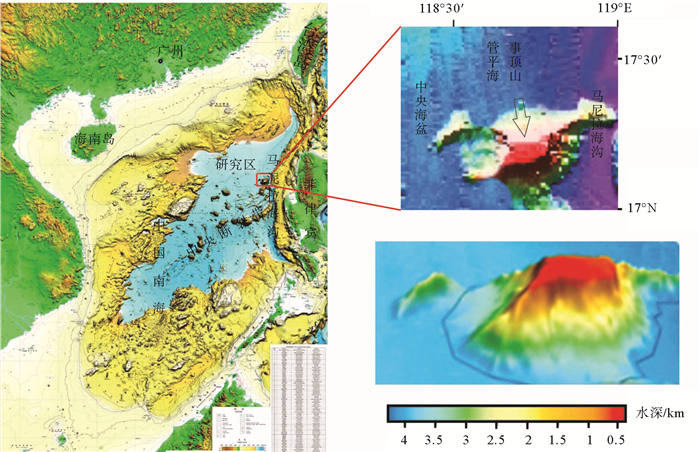
 下载:
下载:
